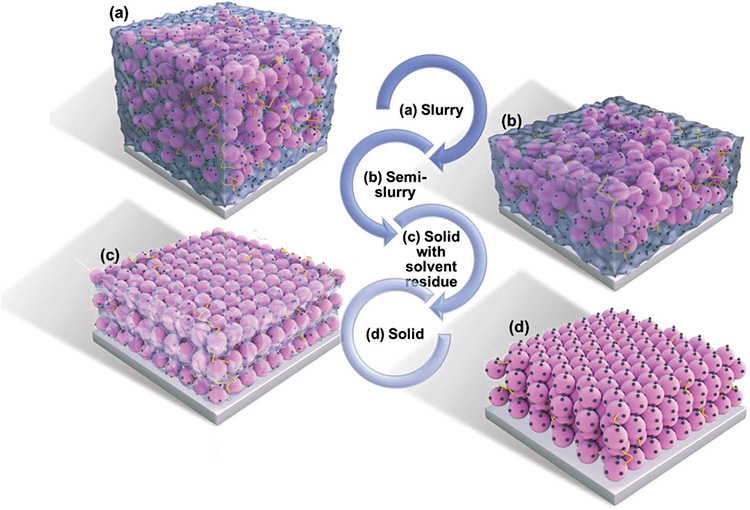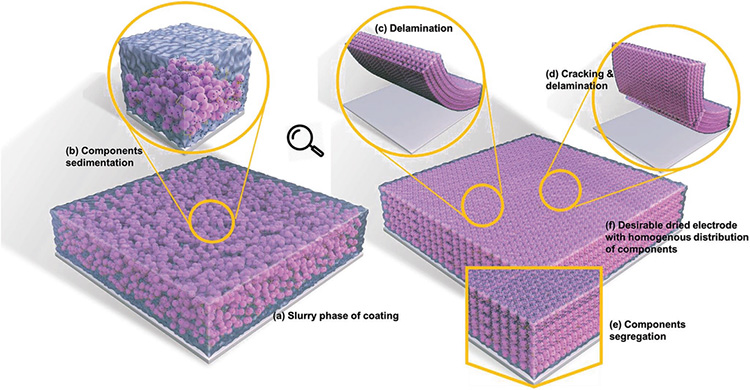The manufacturing process for lithium-ion batteries is extremely complex, especially because there are many controllable parameters during the drying process. These processes affect the porous structure and properties of the electrode film, and ultimately the performance of the battery. However, due to the limitations of existing metrological methods, available drying information is limited and kinetics understanding is poor. In order to better control the quality of electrode coatings, new methods need to be developed to understand drying kinetics.
In this paper, the parameters and variables related to the electrode plate drying process are summarized, and the effects of these parameters and variables on the battery performance are discussed. Based on the existing theoretical models, the research history of drying mechanism is reviewed, and the existing and potential in-situ and off-situ measurement techniques during drying are reviewed.
In this paper, the drying mechanism of polar plate is introduced, and the drying mechanism and model are discussed in order to deepen the understanding of drying kinetics. The effects of different parameters and variables on the structure, physical and electrochemical properties of the electrode were reviewed, and the possible defects and corresponding characterization methods were considered. Finally, the current measurement methods used to measure the effects of drying parameters/variables on electrodes are discussed, and the future improvement directions in the analysis, control and modeling of electrode drying are discussed.
First, drying mechanism.

FIG. 1 summarizes the typical phase transition process during electrode drying. The process can be divided into several stages: aggregation, film curing, film shrinkage and cavity emptying, separation and bonding.
Aggregation refers to the combination of particles, solvents and adhesives to form a semi-solid coating. The fluidity of the initial paste is very important because once the coating loses fluidity, the paste must form a stable network structure. Spontaneous aggregation and evaporation-induced aggregation mechanisms are proposed. In this model, reducing the evaporation rate can increase the interface area.
In the film curing stage, a surface curing layer is formed on the surface of the coating. The curing layer grows as the solvent evaporates and the area of the curing layer expands until it approaches the base. As the solvent evaporates, the binder migrates with the solvent, and once the shrinkage of the film stops, the migration stops. Increasing the temperature can reduce the viscosity of the electrode slurry and reduce settling.
In the film shrinkage stage, the amount of solvent remaining in the binder is low, and the coating eventually shrinks and the holes are emptied. Jaiser assumed that during the shrinkage of the film, the solid groups in the wet film would come into contact with each other, eventually forming connected solid layers during the shrinkage process, and the porous structure would form the backbone of the dry film. During film shrinkage and solvent evaporation, functional additives are mobile and often distributed throughout the film.
During the segregation and bonding phase, a strong bond is formed between the polymer and the substrate, and the residual solvent is removed, thus forming an internal bond between all the particles in the polar plate. Film segregation may occur, and its driving force is closely related to temperature, solvent evaporation rate, drying time and load.
Solvent evaporation controls the different stages of electrode drying and thus the morphology of the film, usually divided into two stages based on solvent concentration, drying rate and moisture content. In the first stage, the solid particles are suspended in a solvent, which evaporates rapidly at a constant rate, and the electrode forms a compact porous structure. The second stage is longer and more complex, the redistribution of conductive additives and binders.
2. Parameters and variables affecting battery performance
The drying process and method are critical for establishing the microstructure of the electrode, the cohesion of the film, and the adhesion to the fluid collection. The components of the electrode paste also need to be well dispersed before deposition, with the active component stabilized in the binder and conductive additives. The most common electrode drying method used in industrial production is with a large conveyor dryer equipped with an infrared radiator or hot air fan. For laboratory pole drying, the conventional method is to apply the slurry to the collector and dry it at room temperature. Inert airflow (for air sensitive materials) is suitable for novel battery materials, such as high nickel NMC or sulfide solid electrolyte air sensitive materials. Inert gases may accelerate DP because heavier gases displace solvents during drying. Rotary drying can also speed up manufacturing, but only for electrodes of certain sizes and shapes. Spray drying method can realize high speed drying and has been widely used in many industries. The residual water in the electrode will cause harmful side reactions and affect the battery performance. The water concentration should be controlled to be less than 100ppm.
Solvent evaporation in industry involves huge energy consumption and is a decisive cost factor in the manufacture of battery electrodes. During electrode manufacturing, the optimal drying rate will promote the balance of binder distribution in electrode film. However, higher drying rates will cause soluble and dispersed binders to be unevenly distributed in the electrode, potentially accumulating on the electrode surface and leading to electrode delamination. Drying temperature and coating thickness also need to be considered, these two factors also have a greater impact on drying time.
The most widely used organic based binders are PVDF and NMP. The use of water-based solvents is expected to result in a two-fold cost reduction in the drying and solvent recovery steps compared to NMP-based solvents. The water-based slurry is characterized by excessive agglomeration of particles, more hydroxyl groups on the surface of the coating, and high surface tension. Additional dispersants need to be added to provide an electrostatic barrier. In addition, the cathode slurry is alkaline and may corrode the aluminum foil, promoting metal dissolution.
The composition and quality of electrode are directly related to the performance of battery. The weight and volumetric energy density of the battery can be achieved by reducing the amount of inactive material, reducing pore volume, and using thinner fluid collectors. The synergistic effect of active substance, binder and conductive carbon in positive electrode and its effect on battery performance are worth exploring.
Due to the complexity of the drying process, which involves coupled mechanical and chemical mechanisms, many parameters and variables are required to describe the system. At present, the main method to analyze the correlation between various drying parameters and variables is still based on trial and error. Therefore, reliable and flexible models are urgently needed to realize the effective analysis of drying parameters/variables. At present, the proposed models are mainly based on mechanism analysis, using physical or chemical equations to describe the drying kinetics, and there are few attempts to use machine learning methods to analyze the parameters of polar plate drying.
Coating defects and their effects on electrode and battery performance

Pinholes, cracks, delamination, and inhomogeneity can generally be controlled by coating and drying rate. Figure 2 shows the causes and effects of the different defects. The main defect types are as follows: 1) binder migration and delamination, 2) component segregation, and 3) film shrinkage cracking. The parameters that affect battery electrode performance during drying and their consequences are summarized in Figure 5. These parameters include drying rate, adhesive type, and formulation. The drying rate is controlled by temperature, pressure, heat radiation intensity and air flow, depending on the drying method; Pastes made from water-based adhesives have a relatively short drying time.
In this paper, the effects of different parameters and variables on electrode structure and properties during electrode drying are discussed and several models of drying kinetics are reviewed. It is expected to reduce the total drying time while maintaining good mechanical properties of the drying electrode coating (especially the adhesion between the electrode film and the fluid collector), thereby increasing the efficiency of the drying step. In addition, according to the scale and characteristics of the analytical measurement methods, they are reviewed and grouped, which provides guidance for researchers to use a wider range of measurement tools to study and monitor the electrode plate manufacturing process.
Contact: Jason Wang
Phone: 13580725992
E-mail: sales@aooser.com
Whatsapp:13580725992
Add: No.429 Guangming Road, Shenzhen City, Guangdong Province
We chat
